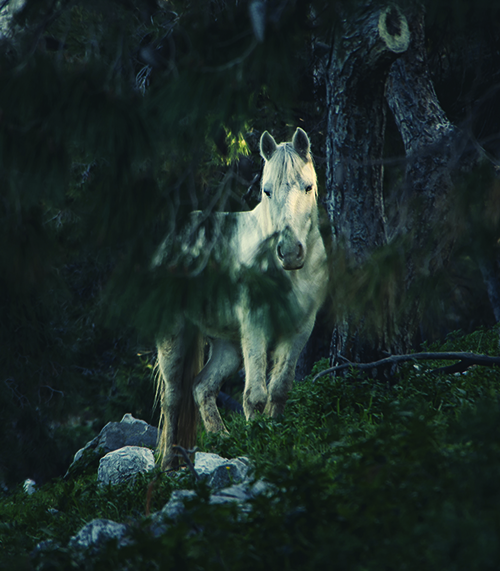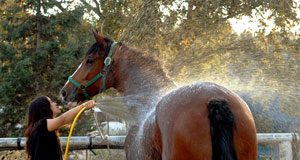The call was from the sheriff’s office. Knowing that it probably wasn’t going to be a quick or easy task, I mentally ran through my appointments for the day.
An injured horse had been discovered by some hikers. They’d tried to lead the horse to safety, but the hurt animal refused to move. The best description I could get was “some sort of leg injury.”
He was way, way back in the high country, deep in an area of backcountry where I wasn’t even sure I could get my vet truck. Fortunately, a deputy who knew the area volunteered to drive me in as close as he could. We’d have to hike the rest of the way to the horse.

Trekking Out
How would I pack a vet kit with so little information? I made my best guesses as to what I’d likely need and met the deputy and an animal control officer at the police station.
We piled into the squad car and began the long climb into the mountainous area. It wasn’t long before we hit unmaintained dirt roads. Conditions deteriorated quickly as gravel turned to mud—and more mud.
We spun furiously up one hill only to slide sideways down the next, and I noticed that conversation had stopped completely as we all hung on for dear life, mud spraying the windows and sides of the squad car. The animal control officer in the backseat was a pale shade of green. I wasn’t in much better shape, but the deputy was chuckling as we sloshed and slid up and down the roads.
“You seem to be enjoying this,” I said as my head bounced off the window and the edge of the road loomed close, then veered away again. I dug my nails into the vinyl covering the armrest, holding on tightly.
“Oh, I’ve been driving these roads since I was a kid,” said the deputy cheerfully. “Know ’em like the back of my hand.”
Suddenly the squad car bucked heavily and jittered sideways, then the back end dropped off the road and the car came to a halt. Everyone was silent.
“Just like the back of your hand, huh?” the animal control officer said dryly. I sighed and reached for my pack. We were marooned in deep mud at the bottom of a steep hill and clambered out, slipping and sliding.
“This way,” the deputy said as he hurried down the shoulder of the road into the woods. “I know a shortcut that’ll get us right to the horse!”
The animal control officer and I had no choice but to follow him, his long legs striding through the trees. He began to climb a steep hill and I huffed after him, my heavy pack rattling against my back and legs.
We reached what I thought was the top, only to see another tree-covered mountain stretching away above us, the deputy never slowing his pace as he continued his rapid climb uphill.
After a 20-minute sweaty trek, we heard a voice hollering and the deputy hollered back and changed his course slightly. We traversed along a ridge, then dropped off the backside into a gully.
The Horse at Last
I could see the white horse below us, standing with one front leg extended. I forgot my fatigue and sped down the backcountry hill to my patient.
As I approached, I could see it was a mare, and she bobbed her head up and down unhappily, a horrible laceration on her front leg. I spoke to her gently as she sniffed my hand and arm. I was able to slide my halter over her head.
She had a fever and an elevated heart rate, and the leg was hard, hot and swollen with infection. There was a not-very-fresh laceration exposing part of a flexor tendon, and she trembled as I palpated the sore leg.
We brought her a small collapsible container of water, which she drank rapidly. I placed an IV and ran 5 liters of fluids, which was all that I’d been able to carry.
I injected a mild sedative and pain and anti-inflammatory medicines, then went to work on the awful injury. I removed a great deal of debris from the tissues, cleaned the tendon and its glistening sheath carefully, and infused antibiotic into every crevice.
Suturing was impossible; the tissues were dry and contracted, so I packed the clean wound with saline-soaked gauze sponges and bandaged it under a thick wrap.
We gave her a little more to drink, and she was much brighter, venturing a step or two on the leg. After some coaxing, she began to hobble, then to walk, her strides improving quickly, and she eagerly marched over to a grassy section and ate with gusto. I gave her several different antibiotic shots as she grazed, and soon we were ready to begin the trip out of the backcountry.
End of the Backcountry Journey
The mare did her best, but it was slow going. We were all exhausted when we finally exited the backcountry and reached a road where a trailer could get to us. It was another long wait for the trailer, but the mare happily grazed while we rested, and soon we had her loaded and headed back into town.
The mare had surgery the next day and went on to make a full recovery. The owner, a kind older gentleman, was located by the animal control officer, and was deeply grateful for the care we’d given his sweet mare whose name turned out to be Betsy Ross. He paid his bill in full and he and his wife sent lovely thank-you cards to everyone who helped save Betsy.
But I never did find out how the deputy got his squad car out.
This article originally appeared in the August 2019 issue of Horse Illustrated magazine. Click here to subscribe!






